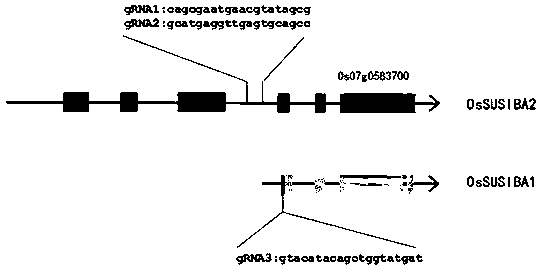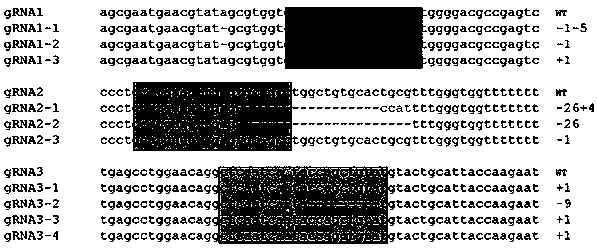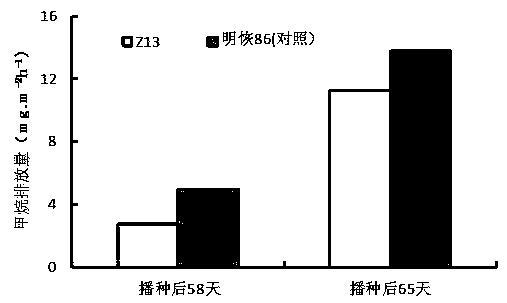Creation method of low-methane-emission paddy rice variety
A rice and methane technology, applied in the field of gene editing technology and crop breeding, can solve the problems of reducing the amount of methane in rice fields and poor results, and achieve the effect of high efficiency and low cost
- Summary
- Abstract
- Description
- Claims
- Application Information
AI Technical Summary
Problems solved by technology
Method used
Image
Examples
Embodiment 1
[0029] Example 1: Sequence analysis and gene editing target design of rice susiba-like gene
[0030] The sequence of the rice susiba-like gene is shown in SEQ ID NO.1. Sequence analysis shows that the gene contains 7 exons, respectively 46-291 (first exon), 1352-1525 (second exon), 2529-3072 (third exon) in the sequence table. exon), 3674-3839 (fourth exon), 3926-4084 (fifth exon), 4481-5048 (sixth exon).
[0031] The material tested was Minghui 86, so according to the experimental purpose of the present invention, three cas9 recognition sites were designed on the third intron and the fourth exon, such as figure 1 . The recognition target sequences are gRNA1: ggtggtagagcctccaatag (promoter region), gRNA2: gcatgaggttgagtgcagcc (promoter region), gRNA3: gtacatacagctggtatgat (coding region).
Embodiment 2
[0032] Example 2: Construction of Targeting Vector and Genetic Transformation of Rice
[0033] In this experiment, the CRISPR / cas9 vector was purchased from Beijing Weishang Lide Biotechnology Co., Ltd. The backbone vector pCXUN-Cas9 contains an artificially synthesized cas9 protein sequence of 4206 base pairs, which can encode 1401 amino acids and is driven by a Ubiquitin promoter. U6 Promoter. Two promoters drive the transcription of cas9 protein and gRNA respectively. The fragment was synthesized by Primer Synthesis Co., Ltd. and connected to the U6 promoter by DNA ligase to form a recombinant plasmid pCXUN-Cas9-gRNA (circular vector).
[0034] In the present invention, the Agrobacterium carrying the vector pCXUN-Cas9-gRNA can transform the callus of japonica rice, indica rice and glutinous rice, and obtain transgenic materials through screening, differentiation and rooting of resistant callus, Minghui 86 is as follows For example, the specific steps are as follows:
[0...
Embodiment 3
[0040] Example 3: Genotype detection and phenotype investigation of rice susiba-like gene edited body
PUM
 Login to View More
Login to View More Abstract
Description
Claims
Application Information
 Login to View More
Login to View More - R&D
- Intellectual Property
- Life Sciences
- Materials
- Tech Scout
- Unparalleled Data Quality
- Higher Quality Content
- 60% Fewer Hallucinations
Browse by: Latest US Patents, China's latest patents, Technical Efficacy Thesaurus, Application Domain, Technology Topic, Popular Technical Reports.
© 2025 PatSnap. All rights reserved.Legal|Privacy policy|Modern Slavery Act Transparency Statement|Sitemap|About US| Contact US: help@patsnap.com



